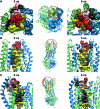Cystic fibrosis transmembrane conductance regulator: using differential reactivity toward channel-permeant and channel-impermeant thiol-reactive probes to test a molecular model for the pore
- PMID: 19754156
- PMCID: PMC2765204
- DOI: 10.1021/bi901314c
Cystic fibrosis transmembrane conductance regulator: using differential reactivity toward channel-permeant and channel-impermeant thiol-reactive probes to test a molecular model for the pore
Abstract
The sixth transmembrane segment (TM6) of the CFTR chloride channel has been intensively investigated. The effects of amino acid substitutions and chemical modification of engineered cysteines (cysteine scanning) on channel properties strongly suggest that TM6 is a key component of the anion-conducting pore, but previous cysteine-scanning studies of TM6 have produced conflicting results. Our aim was to resolve these conflicts by combining a screening strategy based on multiple, thiol-directed probes with molecular modeling of the pore. CFTR constructs were screened for reactivity toward both channel-permeant and channel-impermeant thiol-directed reagents, and patterns of reactivity in TM6 were mapped onto two new, molecular models of the CFTR pore: one based on homology modeling using Sav1866 as the template and a second derived from the first by molecular dynamics simulation. Comparison of the pattern of cysteine reactivity with model predictions suggests that nonreactive sites are those where the TM6 side chains are occluded by other TMs. Reactive sites, in contrast, are generally situated such that the respective amino acid side chains either project into the predicted pore or lie within a predicted extracellular loop. Sites where engineered cysteines react with both channel-permeant and channel-impermeant probes occupy the outermost extent of TM6 or the predicted TM5-6 loop. Sites where cysteine reactivity is limited to channel-permeant probes occupy more cytoplasmic locations. The results provide an initial validation of two, new molecular models for CFTR and suggest that molecular dynamics simulation will be a useful tool for unraveling the structural basis of anion conduction by CFTR.
Figures








References
Publication types
MeSH terms
Substances
Grants and funding
LinkOut - more resources
Full Text Sources

